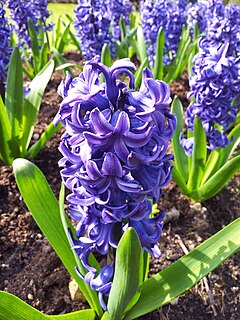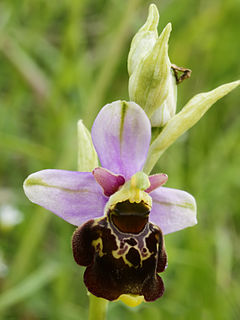
Royal Botanic Gardens, Kew, is a non-departmental public body in the United Kingdom sponsored by the Department for Environment, Food and Rural Affairs. An internationally important botanical research and education institution, it employs 1,100 staff. Its board of trustees is chaired by Dame Amelia Fawcett.

Hyacinthus is a small genus of bulbous, spring-blooming perennials. They are fragrant flowering plants in the family Asparagaceae, subfamily Scilloideae and are commonly called hyacinths. The genus is native to the area of the eastern Mediterranean from the north of Bulgaria through to the northern part of the region of Palestine.

Orchis mascula, the early-purple orchid, early spring orchis, is a species of flowering plant in the orchid family, Orchidaceae.

Pancratium is a genus of African and Eurasian perennial, herbaceous and bulbous plants in the Amaryllis family, subfamily Amaryllidoideae

Puschkinia is a genus of three known species of bulbous perennials in the family Asparagaceae, subfamily Scilloideae. It is native to the Caucasus and the Middle East. Puschkinia scilloides is grown as an ornamental bulbous plant.

Allium nigrum, common name black garlic, broad-leaved leek, or broadleaf garlic, is a Middle Eastern species of wild onion. It lacks the onion or garlic scent shared by most of the other species in the group. The species is native to Turkey, Cyprus, Syria, Lebanon, and Israel but cultivated as an ornamental in many other places. It has become naturalized in some regions, including parts of the United States.

Ophrys fuciflora is a species of flowering plant in the orchid family. It is widespread across much of Europe from Britain and Spain to Turkey and Romania, plus Libya and the Middle East as far east as Iraq.

Biarum is a genus of flowering plants in the family Araceae. It is composed of plants that are native to the Middle East, southern Europe, and North Africa. Biarum are often found growing in rock crevices and graveled soil composed largely of limestone.
Lycochloa is a genus of Lebanese plants in the grass family. The only known species is Lycochloa avenacea, found only in Lebanon.
Crithopsis is a genus of plants in the grass family, native to the Mediterranean and nearby areas.
The World Checklist of Selected Plant Families is an "international collaborative programme that provides the latest peer reviewed and published opinions on the accepted scientific names and synonyms of selected plant families." Maintained by the Royal Botanic Gardens, Kew, it is available online, allowing searches for the names of families, genera and species, as well as the ability to create checklists.
Arum hygrophilum is a species of flowering plant in the Araceae family. It has a disjunct distribution, found in Israel, Jordan, Lebanon, Syria, Cyprus and Morocco.

Michauxia is a genus of plants in the family Campanulaceae. It contains 7 known species native to southwestern Asia.
Gagea ramulosa is a Eurasian and North African plant species in the lily family. It is native to France, Sardinia, Sicily, Greece, Turkey, Libya, Ukraine, European Russia, Caucasus, Syria, Lebanon, Iraq, Iran, and Afghanistan. Some authors consider this to be the same species as G. dubia, but the World Checklist does have it listed as a distinct species.

Tulipa agenensis is a Middle Eastern species of flowering plants in the family Liliaceae. It is native to Turkey, Iran, Cyprus, the Aegean Islands, Syria, Lebanon, Israel, Jordan, and Palestine, and naturalized in the central and western Mediterranean.

Acantholimon libanoticum(Lebanese prickly thrift, غملول لبناني) is a plant in the family Plumbaginaceae first described by Pierre Edmond Boissier. It is native to Western Asia from Turkey to Syria and Lebanon.

Alchemilla diademata, also known as the diadem lady's mantle, is a species of the genus Alchemilla endemic to Lebanon. The plant has been commonly used in folk medicine in Lebanon and its promising bioactive properties have been subject to a number of studies.
Asperula glomerata is a species of flowering plant in the family Rubiaceae. It was first described in January 1846 and is endemic to Afghanistan, Iran, Iraq, Kazakhstan, Kirgizstan, Lebanon-Syria, Pakistan, Palestine, Tadzhikistan, Transcaucasus, Turkey, Turkmenistan, and Uzbekistan.

Aubrieta libanotica, common name Lebanese rock cress, is a species of flowering plant in the mustard family Brassicaceae. The genus is named after Claude Aubriet, a French flower painter. A. Libanotica is native to the mountainous ranges of Lebanon and some parts of Syria.












